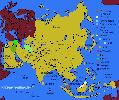|
|
|
|
|
|
|
|
|
|
|
|
|
|
| | |
|
|
|
|
| | |
| Name | latin |
Ceratomantis saussurii |
| english |
Unicorn Mantis |
| |
|
| | IGM-Number | 73 |
| |
|
| Systematics
Systematics
|
|
All data for the systematics is taken from Reinhard Ehrmann's book "Mantodea - Gottesanbeterinnen der Welt" (Mantodea - Praying mantids of the world).
More about this book can be found in the section literature at this page.
|

|

| Super-Order |
Dictyoptera |
| Order |
Mantodea |
| Family |
Hymenopodidae |
| Subfamily |
Oxypilinae |
| Tribe |
Oxypilini |
| |
|
| | First Description | Author |
WOOD-MASON |
| Year |
1876 |
| |
|
| Size
Quotation of Size
|
|
The given size is measured from the head to the end of the abdomen, without the wings.
|

|

| Male |
approx 2,5cm |
| Female |
approx 2,5cm |
| |
|
| Lifespan
Quotation of the Lifespan
|
|
The lifespan is given in month and has the following definition:
overall-age ("time between hatching and imago" + "lifespan after the last molting")
Example: 9 (2 + 7) month lifespan
overall-age = 9 month
time between hatching and imago = 2 month
lifespan after the last molting = 7 month
|

|

| Male |
approx 6 (4 + 2) months / ~ 8 moltings |
| Female |
approx 12 (4 + 8) months / ~ 8 moltings |
| |
|
| Sexing
Sexing
|
|
Morphologically differences between male and female.
|

|

| Male |
L5 and above: only by counting the abdominal segments at the bottom of the abdomen (8 segments)
adult: the wings are longer than the wings of the females, a more thinner body, otherwise by counting the segments |
| Female |
L5 and above: only by counting the abdominal segments at the bottom of the abdomen (6 segments)
adult: big abdomen, the wings are shorter, otherwise by counting the segments |
| | |
|
| | | | Spreading
Spreading
|
|
For a better overview, only whole countries are listed for the quotation of spreading, even if a species can only be found in a small part of that country.
All data for the spreading is taken from Reinhard Ehrmann's book "Mantodea - Gottesanbeterinnen der Welt" (Mantodea - Praying mantids of the world).
More about this book can be found in the section literature at this page.
At the menu "Spreading" for each country only the genus but the species is printed (Exception: on this site described species).
|

|

| Borneo, South-Myanmar, Thailand, Malaysian Peninsular |
| The description is based on mantids of the following origin:
Pak-Chong (Thailand) |
| |
| |
|
| |
 |
| Asia |
|
| | Habitat | bushes
inhabits damp areas |
| |
|
| | Aggressiveness | low |
| |
|
| | Colorvariants | none |
| |
|
| | Hint | They often trill the air with their antennas.
They escape by doing many short jumps. |
| |
|
|
| |
|
|
|
|
|
|
|
|
|

